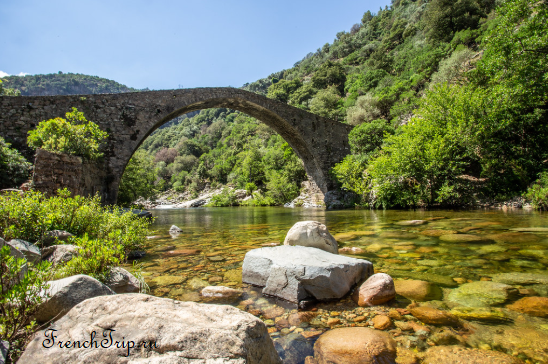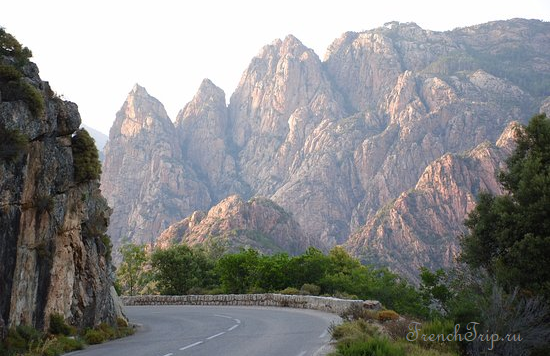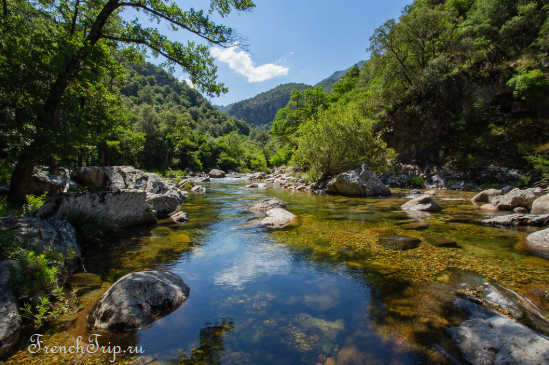Ota

The town of Ota in the picturesque Gulf of Porto in western Corsica is surrounded by two mountain ranges. Built on the slopes of Mount Capu d’Ota (1220 m) at an altitude of 337 meters, it is surrounded by numerous olive groves and cedar forests, and the local houses are more like small fortresses on the rocks. The village gives access to the Gorges de la Spelunca, which is home to another Genoese-era bridge, the Zaglia Bridge, located along the “Tra Mare i Monti” path, a former mule road linking Ota and Evisa.
The small town of Ota also has a town hall and a school located in the basement of the town hall. There are also many Corsican specialty restaurants. To the east of the village, the ancient Genoese Pianella Bridge spans the Porto River:

Getting to Ota:
The town of Ota, like Porto, is served by rare buses from Ajaccio and Calvi, connecting these cities with Porto, Evisa and Ota. The schedule and prices can be found on the Porto page.
Ota attractions:
Castello di Rocche di Sia
The castle was built in 1413 by Rinuccio de Leca, Lord of Vico (1378-1445), who then rebelled against the Genoese. Its defenses were strengthened in 1426.
The fort changed hands several times during the feudal wars of the 15th century. In 1457, the Banco di San Giorgio installed a garrison there before destroying the castle in 1461. Rebuilt shortly after the territory came under the rule of the Dukes of Milan, it was reoccupied in the fourth quarter of the 15th century by the Lords of De Leca, it would be handed over to the Banco di San Giorgio again after the agreed capitulation of Giovanna Paolo di Leca in 1487. The fortress would be finally destroyed in 1492 by order of the Protecteurs de l’Office.
The ruins of the castle are now classified as a historical monument.
Blast furnace, mini-mill and hydraulic sawmill
These industrial structures date back to 1865, 1883. In 1890, the company employed sixty workers. In 1910, it ceased all activity. The remains of a tall wood-fired oven, two iron ore grills and a building are preserved on the former industrial site. They are included in the general inventory of cultural heritage.
Parish Church of Saint John the Baptist
The parish church of Saint John the Baptist (Église Saint-Jean-Baptiste), called the Piedmontese Church of Saint John the Baptist in Sia (Saint-Jean-Baptiste de Sia), is located in a place called Chiesa Vecchia near the Cemetery of Ota. It was probably built in the eleventh century and was the main church of Pieve de Sia in the Middle Ages. Pillaged at the end of the fifteenth century by the Genoese troops of the Chancellery of Saint George, it was renovated at the beginning of the sixteenth century.
The church was rebuilt between 1698 and 1702. In 1750 it was considered “obsolete and too small to accommodate all the faithful”; The construction of a new building on a different site began in 1761.
Genoese Bridge of Pianella
The Genoese Bridge at Pianella, located on the Porto River, downstream from the confluence of the Lonca and Tavulella streams, at the exit of the Spilonca Gorge. Built in the 15th century, the bridge has a semicircular arch of 15.30 meters. The bridge is classified as a historical monument.

Church of Saint Lucia
Église Sainte-Lucie is a small votive church situated in its namesake location, near a spring and the remnants of a Roman site. Although its exact age is unclear, it was first documented in 1775.
The church holds significant cultural importance as a traditional pilgrimage site for the residents of Porto’s upper valley, who visit from the village of Ota on December 13 each year. It underwent restoration in the late 19th century and again at the close of the 20th century.
Privately owned, the church is recognized as a cultural heritage monument in France.
Gorges de la Spelunca
The Gorges de la Spelunca cover an area of 263 hectares in the municipalities of Evisa, Ota and Marignane. It extends upstream from the village of Ota, starting from the Genoese Pianella bridge, which crosses the confluence of the Lonca and Porto.
The gorge contains two species of birds: the European hawthorn (Accipiter nisus) and the white-bellied martinet – alpine martinet (Tachymarptis melba). Read more…

The stunning Gorges de la Spelunca, located inland from Porto, offer excellent routes for mountain trekking, hiking, and even swimming in fresh water on hot days. The 45-minute trail, marked with orange signs, heads east through the heart of the canyon from the bridge over the Porto River, 2km east of Ota on the D124, to the Zaglia Bridge, an 18th-century Genoese stone bridge.
For a longer hike, walk the entire route from Ota to Evisa (2.5 hours each way).

You can simply drive to the river and swim there without having to hike. There are many pools to splash around in, some deep enough for jumping and swimming. It can get very crowded on hot days in the summer, so get there early. There are plenty of places for little ones and big kids.

Ota on the map of France:
→ Get back to Corsica travel guide
Archives
Calendar
| M | T | W | T | F | S | S |
|---|---|---|---|---|---|---|
| 1 | 2 | 3 | 4 | 5 | 6 | 7 |
| 8 | 9 | 10 | 11 | 12 | 13 | 14 |
| 15 | 16 | 17 | 18 | 19 | 20 | 21 |
| 22 | 23 | 24 | 25 | 26 | 27 | 28 |
| 29 | 30 | 31 | ||||